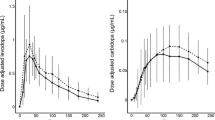Abstract
Despite the significant symptomatic effects of levodopa, stable 24-h treatment responses are in the vast majority of patients replaced 2–3 years from the start of treatment by oscillations in motor symptoms (fluctuation, dyskinesia), amelioration of which requires addition of constant (physiological) stimulation of postsynaptic dopamine receptors. To some extent this is provided by Stalevo, which contains levodopa and two enzyme inhibitors: the DDC inhibitor carbidopa and the COMT inhibitor entacapone. The results obtained in the present study demonstrated the advantages of Stalevo over traditional agents in patients with the “wearing off” and “on-off” phenomena.
Similar content being viewed by others
References
A. N. Boiko, T. T. Batysheva, E. S. Chikina, et al., “Experience in the use of dopamine receptor agonists in the out-patient treatment of Parkinson's disease,” Zh. Nevrol. Psikhiat., 103, No. 9, 54–58 (2003).
A. N. Boiko, T. T. Batysheva, E. S. Chikina, et al., “Use of Tremonorm in Parkinson's disease: experience of the out-patient neurological service of the Moscow City Health System,” Zh. Nevrol. Psikhiat., 104, No. 12, 23–28 (2004).
A. N. Boiko, T. T. Batysheva, E. S. Chikina, et al., “Efficacy of PK-Merz in Parkinson's disease in out-patient practice,” Lech. Nerv. Bolezn., 2, 23–27 (2005).
V. L. Golubev, Ya. I. Levin, and A. M. Vein, Parkinson's disease and Parkinson's Syndrome [in Russian], Medpress, Moscow (1999).
V. L. Golubev and A. A. Palipovich, “New possibilities in the treatment of Parkinson's disease with Stalevo (levodopa/carbidopa/entacapone),” Lech. Nerv. Bolezn., 1, 1–11 (2006).
O. S. Levin, “Development of motor fluctuations in patients with different stages of Parkinson's disease,” Atmosfera (Nerv. Bolezn., 1, 10–16 (2005).
O. S. Levin and N. V. Fedorova, Parkinson's disease [in Russian], Moscow (2006).
N. V. Fedorova, O. V. Krivonos, I. P. Chigir', et al., “Use of catechol-O-methyltransferase (COMT) inhibitors in the treatment of the late stages of Parkinson's disease,” Kreml. Med., 2, 66–72 (2001).
N. V. Fedorova, O. S. Levin, I. G. Smolentseva, et al., “A new-generation levodopa preparation — Stalevo (levodopa/carbidopa/entacapone), in the treatment of Parkinson's disease,” Zh. Nevrol. Psikhiat., 9, 39–46 (2006).
V. N. Shtok, and N. V. Fedorova, Parkinson's disease. Extrapyramidal Disorders. Handbook for Diagnosis and Treatment [in Russian], Medpress-Inform, Moscow (2002), pp. 87–124.
D. Brooks, H. Sagar, and the UK-Irish Entacapone study group, “Entacapone is beneficial in both fluctuating and non-fluctuating patients with Parkinson's disease. A randomized, placebo-controlled, double-blind six-month study,” J. Neurol. Neurosurg. Psychiat., 74, 1064–1072 (2003).
D. Brooks, Y. Agid, K. Eggert, et al., “NC-INIT Study Group. Treatment of end-of-dose wearing-off in Parkinson's disease: Stalevo (levodopa/carbidopa/entacapone) and levodopa/DDCI given in combination with Comtess/Comtan (entacapone) provide equivalent improvements in symptom control superior to that of traditional levodopa/DDCI treatment,” Eur. Neurol., 53, No. 4, 197–202 (2005).
P. Jenner, “Avoidance of dyskinesia: preclinical evidence for continuous dopaminergic stimulation,” Neurology, 62, Supplement 1, 47–55 (2004).
T. Müller, C. Erdmann, S. Muhlack, et al., “Inhibition of catechol-O-methyltransferase contributes to more stable levodopa plasma levels,” Mov. Dis., 21, No. 3, 332–336 (2006).
D. Nyholm, A. I. Nilsson Remahl, N. Disdar, et al., “Duodenal levodopa infusion monotherapy vs oral polypharmacy in advanced Parkinson disease,” Neurology, 64, No. 2, 216–223 (2005).
C. W. Olanow, K. Kieburtz, M. Stern, et al., “Double-blind, placebo-controlled study of entacapone in levodopa-treated patients with stable Parkinson disease,” Arch. Neurol., 61, No. 10, 1563–1568 (2004).
C. W. Olanow and F. Stocchi, “COMT inhibitors in Parkinson's disease: can they prevent and/or reverse levodopa-induced motor complications?” Neurology, 62, Supplement 1, 72–81 (2004).
R. Pahwa, K. Lyons, D. McGuire, et al., “Comparison of standard carbidopa-levodopa and sustained-release carbidopa-levodopa in Parkinson's disease: pharmacokinetic and quality-of-life measures,” Mov. Dis., 12, No. 5, 677–681 (1997).
W. Poewe and G. Wenning, “Levodopa in Parkinson's Disease: mechanisms of action and pathophysiology of late failure,” in: Parkinson's Disease, Movement Disorders, J. J. Jankovic and E. Tolosa (eds.) (2002), pp. 104–115.
W. H. Poewe, G. Deuschl, A. Gardin, et al., “Efficacy and safety of entacapone in Parkinson's disease patients with suboptimal levodopa response: a 6-month randomized placebo-controlled double-blind study in Germany and Austria (Celomen study),” Acta Neurol. Scand., 105, 245–255 (2002).
A. H. Schapiro and J. Obeso, “Timing of treatment initiation in Parkinson's disease: a need for reappraisal,” Ann. Neurol., 59, No. 3, 559–562 (2006).
A. Schrag, “Entacapone in the treatment of Parkinson's disease,” Lancet. Neurol., 4, No. 6, 366–370 (2005).
Author information
Authors and Affiliations
Additional information
__________
Translated from Zhurnal Nevrologii i Psikhiatrii imeni S. S. Korsakova, Vol. 107, No. 12, pp. 21–24, December, 2007.
Rights and permissions
About this article
Cite this article
Boiko, A.N., Batysheva, T.T., Minaeva, N.G. et al. Use of the new levodopa agent Stalevo (levodopa/carbidopa/entacapone) in the treatment of Parkinson's disease in out-patient clinical practice (the START-M open trial). Neurosci Behav Physi 38, 933–936 (2008). https://doi.org/10.1007/s11055-008-9085-3
Published:
Issue Date:
DOI: https://doi.org/10.1007/s11055-008-9085-3




